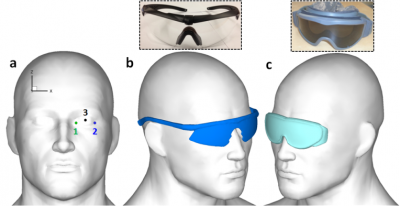
Ocular trauma is one of the most common types of combat injuries resulting from the exposure of army/security personnel with improvised explosive devices. Specifically, in India and other terrorism affected nations, there are several cases of injury of human eyes caused by the blasts. Ocular blast injury mechanisms are complex, and trauma may occur through various injury mechanisms. Since blast field measurements are not trivial, we used computational modeling to reconstruct the TNT blast events on an anatomically accurate human face and eye. Using advanced 3D computational model, we assessed the effectiveness of the eye armor (Fig. 1) during blast loading on human eyes subjected to TNT blasts. We compared and validated computed results against free field blast measurements and reconstructed events which happens on an ultrafast time scale (milliseconds).
In Ref. [1], we evaluated the effectiveness of spectacles and goggles in mitigating the pressure loading using the computational model. Our results corroborate experimental measurements showing that the goggles were more effective than spectacles in mitigating blast overpressure loading on the eye. Numerical results confirmed that the goggles significantly reduced blast wave penetration in the space between the armor and the eyes and provided larger clearance space for blast wave expansion after penetration than the spectacles (Fig. 2b, c). The spectacles as well as the goggles were more effective in reducing reflected BOP at higher charge mass because of the larger decrease in dynamic pressures after the impact. The goggles provided greater benefit of reducing the peak pressure than the spectacles for lower charge mass. However, the goggles resulted in moderate,sustained elevated pressure loading on the eye, that be came 50-100% larger than the pressure loading experienced by the unprotected eye after 0.2 ms of impact of blast wave, for lower as well as higher charge mass.
Prof. Rajneesh Bhardwaj
